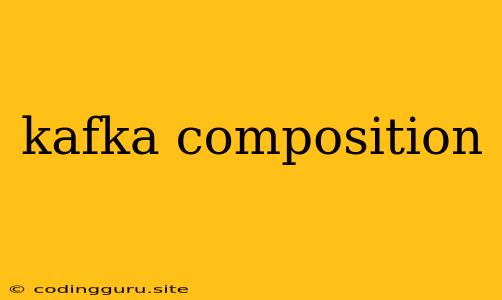What is Kafka Composition?
Kafka, a distributed streaming platform, is a powerful tool for building real-time data pipelines. But as your applications grow and your data volumes increase, you might find yourself dealing with complex data structures and the need for data transformations. This is where Kafka composition comes into play.
Kafka composition is a technique that allows you to combine data from multiple Kafka topics into a single stream, transforming it as you go, and outputting it to another topic. It's a crucial approach for handling complex data workflows and building more robust and flexible streaming applications.
Why use Kafka composition?
Imagine you have multiple Kafka topics containing different types of data. You might have one topic for user events, another for product updates, and yet another for payment transactions. You need to combine this data to gain a holistic view of your users' interactions with your application.
This is where Kafka composition comes in. By combining data from multiple topics, you can create a single, enriched stream that provides a unified picture of your data. This unified stream can then be used for analytics, alerting, or even triggering other applications.
How does Kafka composition work?
Kafka composition is typically achieved through Kafka Streams, a Java library for building applications that process streams of data. Kafka Streams allows you to define KStream objects, which represent streams of data from specific topics. These KStream objects can then be manipulated and combined using various operations like:
map: Transform each record in a stream.flatMap: Create multiple records from a single record.filter: Select specific records based on a condition.join: Combine data from two streams based on a common key.aggregate: Group data by key and apply an aggregation function.
By chaining these operations, you can create complex pipelines that transform and combine data from multiple sources.
Examples of Kafka composition
Here are some real-world examples of how Kafka composition can be used:
1. User activity tracking: Combine data from topics containing user login events, product views, and purchase orders to create a single stream representing a user's complete activity journey. This stream can be used to personalize recommendations, detect fraudulent activity, or track user engagement.
2. Fraud detection: Combine data from payment transactions, user profiles, and shipping data to build a stream that flags suspicious transactions in real-time. This stream can trigger alerts or trigger automatic investigations to prevent financial losses.
3. Order fulfillment: Combine data from order placement, inventory management, and shipping logistics to build a stream that tracks the progress of each order. This stream can provide real-time updates to customers, optimize delivery routes, and ensure timely order fulfillment.
Tips for effective Kafka composition
- Choose the right approach: Kafka composition can be achieved through various techniques, including Kafka Streams, Apache Flink, or even custom applications. Select the approach that best fits your needs and technical expertise.
- Design clear data models: Ensure your data schemas are well-defined and consistent across different topics to make data transformation and integration easier.
- Use partitioning and scaling: As your data volume grows, partition your topics and scale your Kafka cluster to handle increased throughput.
- Monitor performance: Regularly monitor your Kafka composition pipelines to ensure they are performing efficiently and to identify any bottlenecks.
- Use state management: For more complex workflows, consider using Kafka Streams' state management capabilities to store intermediate results and maintain consistency across operations.
Conclusion
Kafka composition is a powerful technique for handling complex data workflows and building robust streaming applications. By understanding the concepts and applying the right strategies, you can leverage Kafka composition to transform and enrich your data streams, enabling you to build more intelligent and data-driven applications.
